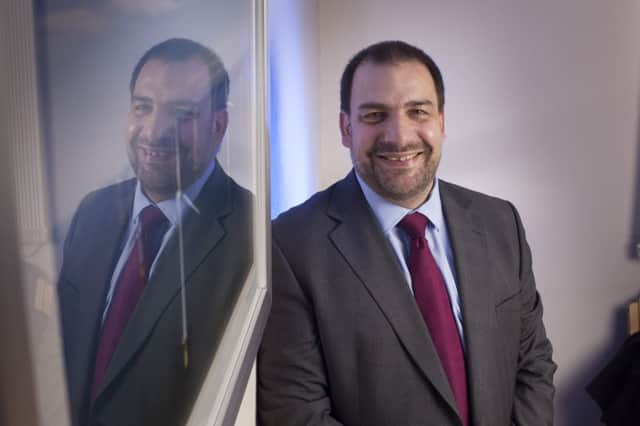Monday Interview: Andrew Jamieson, ORE Catapult


When schooling confirmed his aptitude for maths and science, there was no longer any question that he would one day be an engineer.
However, it wasn’t until his fifth and final year that he settled on a specific discipline, triggered by a school trip to Hunterston Power Station. The enormity of the nuclear plant, with hundreds of thousands relying on it for power, left a lasting impression upon Jamieson.
Advertisement
Hide AdAdvertisement
Hide Ad“Knowing that so many people were using it right at that moment, you get a real connection for what it all means,” he says. “I think that is what threw me into electrical engineering rather than say mechanical or structural engineering. Walking into any large powerstation, I still get that buzz.”
But the kind of stations Jamieson works with these days bear little resemblance to Hunterston – most call them wind farms. It’s a term that the chief executive of Offshore Renewable Energy (ORE) Catapult would like to abolish.
“It makes it sound as if it is still left-of-centre,” says Jamieson, who argues that offshore wind energy will undoubtedly be an important part of the UK energy mix for decades to come.
While most onshore wind farms tend to be small, installations offshore run into hundreds of turbines. In addition, each of those turbines is significantly larger than its onshore counterpart, with a span bigger than that of the London Eye.
“The energy being generated is on par with that of a conventional plant, with a lot of engineering expertise going into putting those turbines up and keeping them running,” he says.
“That is a power station, not a wind farm. This is an industry – it is not just some random projects.”
Based in Glasgow, ORE Catapult is one of seven technology centres backed by the government to support development in specific industrial areas. Set up through the Technology Strategy Board, its aim is to deliver abundant and affordable energy from renewable offshore sources, including wave and tidal power.
It has been run on skeleton staffing for most of its first year in operation, but now employs 44 people. That is expected to grow to about 100 within a year.
Advertisement
Hide AdAdvertisement
Hide AdOne of their primary tasks is to help bring down the cost of producing offshore renewable energy. In the case of wind, this currently stands at between £130 and £140 per megawatt hour, a figure which government and the industry say needs to fall to about £100.
Jamieson says there is a number of ways this can be achieved, one of which is to take out the expense of custom design by standardising parts andprocedures.
Every offshore installation in the UK to date has been made to a bespoke design, in part because there is a lack of collaboration across the sector. This lack of communication spills over into other areas, such as a reluctance to share data on operating and safety performance.
To tackle this, ORE Catapult has launched its Sparta (System Performance, Availability and Reliability Trend Analysis) project. The aim is to collect and compile data which will then be shared on an anonymous basis across the industry. Six major operators have signed up, covering virtually all of the UK’s offshore installations.
“In conventional plants, gas and coal-fired plants, this has existed for ages,” says Jamieson, who spent the first half of what is a 30-year career working in the traditional electricity operations of ScottishPower.
“The difference with offshore renewables is it’s a very young industry, and companies are afraid they might be giving away some advantage by sharing this kind of information. That is why the amount of data is limited in oursector.” He would like to see thedatabase grow to include other types of information, such as the optimum amount of reinforcement required in variable wind conditions, or best practice for safely transporting staff. Better collation of various weather conditions – wind speeds, wave height and so forth – would make the timing in building and maintenance decisions less of a “black art”.
As this information becomes available, start-up firms and university spin-outs should begin to develop solutions to specific problems, unlocking areas of growth. Jamieson says this will evolve into an expert base of knowledge that can be exported, much as Aberdeen’s offshore oil veterans consult in fields around the world.
To mark the centre’s official launch earlier this month, ORE Catapult commissioned research showing that the offshore wind industry could generate as much as £6.7 billion a year in additional value to the UK economy by 2020. By that time, the industry could support as many as 150,000 jobs.
Advertisement
Hide AdAdvertisement
Hide AdJamieson insists all of these goals are within the industry’s grasp.
“I am very committed because I see what is tangible, but also what is feasible, in this sector,” he explains.
“It is not the same thing as sitting around back in the 1950s and saying hey, can we commercialise space and send a man to the Moon and bring him back again? There are hurdles, but they are not insurmountable – we are much closer than that.”
30-second CV
Job: Chief executive, Offshore Renewable Energy Catapult.
Born: Hamilton, 1967.
Education: BSc, electrical engineering, Strathclyde University; MBA, Strathclyde University.
First job: Trainee electrical engineer.
Ambition while at school: Engineering.
Kindle or book? Just now I am still on books.
Can’t live without: I am a big music fan. I have a lot of music on my iPod.
Favourite places: Glasgow, London, New York.
What makes you angry? Non-delivery on things that have been well-planned and thought out. That can be very frustrating.